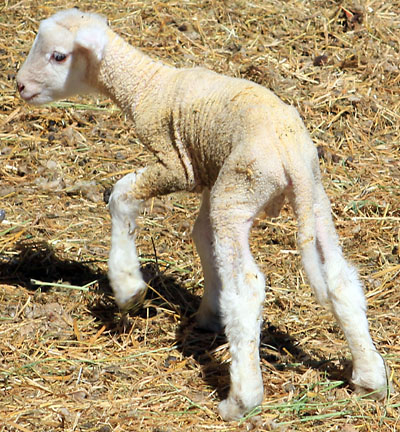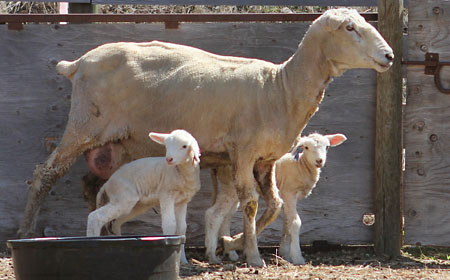 All legs - a BCS lamb, new to the world, tries out its long, long legs. Food and Warmth
BCS Livestock's lambs
story and photos by Karen West
There are dozens of adorable lambs gamboling about on the Smith’s small family farm west of Winthrop right now - late arrivals as valley lamb operations go but just right to fit the schedules of the busy people raising them.
Almost all of the 80 ewes in the flock are Targhee-Columbia crossbred sheep, which is a dual purpose animal that provides both lamb meat and wool used to produce blankets for the family’s BCS Livestock and Methow Valley Woolens businesses. Both products are sold directly to customers. But that soft wool, which eventually will be shipped to a mill on Canada's Prince Edward Island and transformed into blankets, is not what cloaks the newborn lambs, which feel much more like little Berber carpets.
About 50 lambs are expected this season and because they are born in late April, they can be moved to grass pasture on Lower Bear Creek about May 1. “We’re trying to mimic nature’s schedule, which has to do with nutrition and cost,” says Betsy Devin Smith, the B in the BCS Livestock operation, who also is known as one of Winthrop’s veterinarians and an athlete and biathlon coach. The demands of the coaching season are one more factor in determining the timing of the lambs.
The C in BCS is for Casey Smith, who grew up helping his folks raise sheep and who had his own egg business. Before Casey left for college at Montana State University, there were about 200 sheep in the flock, but that had to change when he left home. Casey also is a biathlete and Nordic skier competing internationally. With the ski season behind him, he’s spending a bit of time at home helping his grateful parents.
Skip Smith is the S in BCS. He has his own welding shop in addition to being a rancher. Like most people who make some of their living with a small farm, he and manual labor are well acquainted. And when the sheep start dropping their lambs there is work enough for everyone.
 Exploring - mom takes her new twins on a stroll. The youngest ewes are about a year old, “teenagers” as Devin Smith calls them, and are giving birth for the first time. Ideally, they drop only one lamb on which to practice being mothers. The goal for older ewes is to have them carry twins, although some also drop triplets. Depending on sex, the lambs are given pink or blue ear tags with their birth dates, a vitamin injection and each is recorded in a notebook. Newborns and their mothers are moved into small pens, where “we’re trying to have them bond,” Devin Smith says. The newborns’ long tails are shortened for sanitation reasons by banding them to cut circulation to the lower half, which makes them fall off. Bands also are used to castrate the newborn males.
After the ewes have bonded with their offspring, they are moved to a “mixing pen” large enough for several sets of ewes and lambs. From there they go to a large holding pen to join the whole gang before being put on grass and moved from pasture to pasture. “We mow more than your lawn,” says Devin Smith. “People are happy we’re taking care of their land.”
A few of this year’s lambs will become replacement breeding ewes. Devin Smith explains that they’ll be looking for those that will have a “big capacity” to carry twins and who will milk well, among other traits. But most of the lambs are being raised for meat. And Devin Smith allows that despite decades of raising animals, the day the mobile slaughterhouse arrives is never easy.
But on this warm and sunny spring day, as she watches over numerous lambs trying to figure out how to use their long, awkward legs to explore a whole new world, she says for the next seven or eight months, “They will have a wonderful life.”
4/29/2012
|
